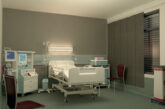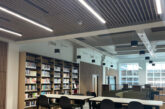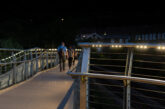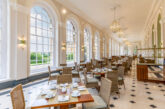
Outdoor lighting is an essential element of any lighting project but with environmental issues such as light pollution and energy use to consider, effective design requires thorough planning and attention. Chris Anderson, Technical Manager at Ansell Lighting explores some of the issues.
With the daylight hours of summer coming to an end, building owners and operators are set to turn their attention to outdoor lighting schemes. Whether that’s repairing or upgrading existing systems or undertaking brand new installations, many choose autumn as the time to ensure everything is in place and operative ahead of the dark, winter months.
Often an insurance or legal health and safety requirement, external lighting is essential for enhancing visibility, safety and security after dark. But with sky high energy bills to contend with more building owners are seeking ways to cut their lighting use and improve energy efficiency. As a result, installers must focus on creating efficient lighting systems that are controllable, responsive and economical to run.
First things first
The first port of call must be replacing any existing lamps with LED light sources. An essential element of any energy efficient lighting installation, LEDs use about 85% less electricity than incandescent bulbs and will help to significantly reduce bills by optimising energy use.
Switching existing fittings to products with either photocell or motion sensor detection technology is also a must. They ensure lighting is only present when the space is in use and can also be used to automate systems so luminaires turn on and off as daylight comes and goes.
But for the ultimate in outdoor lighting efficiency, smart lighting technology offers it all. Whether you opt for replacement lamps which feature the technology or install a fully connected new system, an effective smart lighting installation can reduce lighting energy use by up to two thirds.
One of the key reasons for this is that smart lighting is highly controllable; it allows users to create different scenes, groups and schedules whilst also offering automatic control over factors such as operation times, output levels and colour temperature, all of which impact energy use. This detailed level of automation helps users to achieve optimum levels of energy use and ensure power is only consumed where and when it is needed.
Smart lighting has become much more measurable in recent months, which is another real benefit for users. Utilising dashboard controls, consumption can be viewed in real time, allowing areas in which energy can be saved to be easily identified.
If smart lighting is installed, remember to check that WiFi coverage is sufficient for it to operate fully; if it isn’t, adding a WiFi extender will increase its reach.
Another factor installers should keep in mind when specifying a new smart lighting system is that the products chosen must be interoperable and work together seamlessly with other brands and systems. Previously this has been difficult to achieve as different lighting systems and devices used different communication protocols, but there are now a handful of options such as Zigbee and Bluetooth Mesh that are widely adopted across the industry and can communicate with each other.
Reducing pollution
Aside from energy efficiency, light pollution is another factor impacting outdoor lighting projects. Light pollution is a huge problem in today’s world and unfortunately, much of the lighting we use at night is contributing readily to climate change. Throughout the world, night time lighting is too bright and poorly directed which has led to natural starlight being washed out. This has had an adverse effect on the global ecosystem, disrupting the natural patterns of wildlife and harming human health.
To avoid this, there are now a number of best practice design principles that should be followed to prevent light pollution from occurring. These include ensuring that the light fittings installed are useful, targeted, low level, easy to control and of the right colour. Products that reduce glare and light pollution are also a must.
To make the avoidance of light pollution easier, DarkSky (formerly the International Dark Sky Association) has launched its Fixture Seal of Approval accreditation. Awarded only to products that feature advanced lens technology and enhanced glare control design, it acknowledges those luminaires that will produce minimal levels of light pollution. Where possible, these products should be specified in an outdoor lighting project to ensure compliance.
Browse the latest Ansell Lighting catalogue online here










